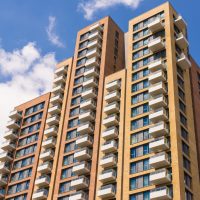
The Building Safety Bill received royal assent and came into force as an Act on 29 April. It was touted as “one of the most anticipated pieces of legislation in recent years” and with good reason following the tragic Grenfell Tower fire that kick-started this legislation. Given the severity of the fire and the lives lost, putting this legislation in place was long overdue.
There has, justifiably, been much celebration of this Act finally coming into being. It will have a substantial impact on everyone from developers, building owners, architects and product manufacturers, through to landlords and tenants in respect of developments at least five storeys or 11 metres in height.
The Act applies to all buildings, not just residential, although, it does contain more stringent measures that focus on “higher-risk buildings”. This applies to those at least seven storeys or 18 metres in height, which have minimum two residential units (or bedrooms for student accommodation). It also includes care homes or hospitals.
However, the Act is not all it appears. To be effective, much of it requires secondary legislation which the government says will be put in place over the next six to 18 months. An example of this is the Fire Safety Act 2022, which came into force on 16 May and demonstrates that there is a focus and drive in parliament to ‘get the job done’.
A positive for residential leaseholders, the Act will introduce what is called “a waterfall system” for liability of costs in residential blocks at least five storeys or 11 metres in height that do not meet the safety standards required. This liability will firstly fall on developers and cladding manufacturers, then on building owners or freeholders, and finally leaseholders. Although, this will be capped for leaseholders at £15,000 in London and £10,000 outside of London for non-cladding work only.
The Act will enable the government to prevent developers obtaining planning permission or building control approval if they fail to pay into a repair fund for fire safety costs.
It also increases the limitation period on defects from six years to 30 years, or to 15 years on new work. However, there could be challenges in that claims from so long ago may well be difficult to evidence. It would be worth the building owner, the landlord and the tenant requesting and keeping copies of paperwork about the building materials that they would never have requested before. This is a key component that clients should be advised on when purchasing a property in a block above five storeys.
Act creates three gateways throughout design and construction process
The Act established three ‘gateways’ to ensure building safety regulations are observed at every stage of design and construction.
Firstly, planning permission will not be granted unless developers can demonstrate that their buildings are designed with fire safety in mind. This must include site layout, water supplies and access for emergency fire vehicles.
Secondly, the Building Safety Regulator will prevent construction unless a control plan has been put in place. This must include reporting on safety concerns; a fire and emergency file and a signed declaration that building safety risk will be managed properly throughout the construction.
Thirdly, the Building Safety Regulator will not release the final certificate until they receive a declaration, co-signed by the client, principal designer and principal contractor, confirming the building complies with the building regulations.
There will be a new regulatory regime for residential buildings at least seven storeys or 18 metres. This will include mandatory registration with the Building Safety Regulator of building inspectors, building control approvers and occupied high-rise residential buildings.
Building owners will be obliged to manage building safety risks on an ongoing basis. This will include a residents’ engagement strategy explaining how they will enable resident participation in decision-making about their building. Residents will themselves be obliged comply with requests for information and not act in a way that creates risks to safety.
In light of the pending secondary legislation, it will be important for brokers who advise developers to have some knowledge and keep updated of what steps their clients will have to go through both to get planning permission and to complete their building as it may well affect what finance they can get.
Similarly, those looking to buy a residential block, or just an apartment within one, would be well advised to know what additional information they ought to be requesting before they go ahead with the purchase.
Ultimately, this long-awaited Act should make it safer and less costly for home and building owners, particularly if they require fire safety-related work carried out on their buildings.
















